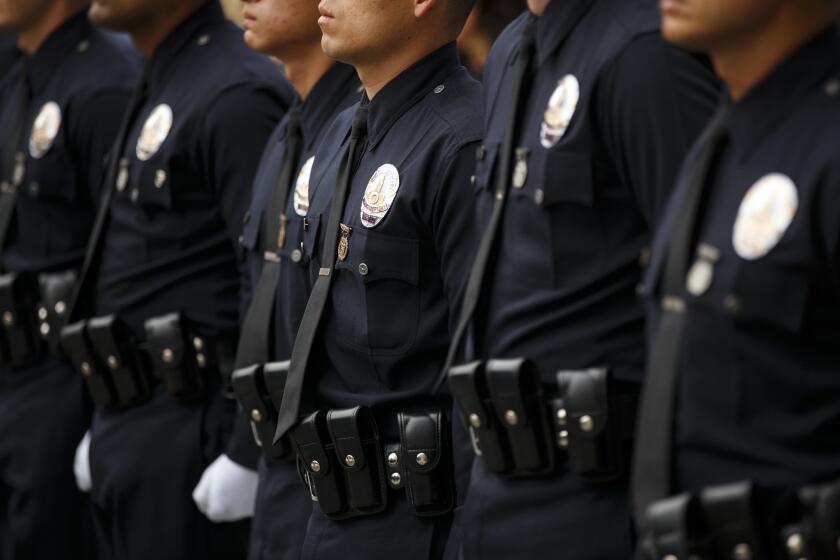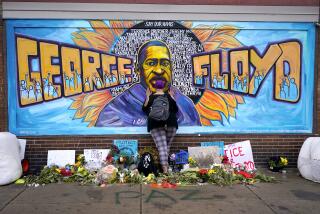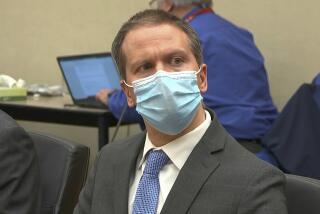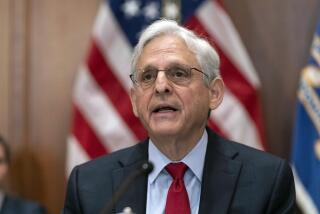Attorney for Minneapolis police officer says he’ll argue George Floyd died of an overdose and a heart condition
- Share via
The public quickly reached its verdict: Minneapolis police killed George Floyd.
Video seen around the world shows him on the pavement, his neck pinned beneath the knee of Officer Derek Chauvin, pleading for his life — “I can’t breathe” — until his body goes limp.
Two autopsies concluded the death was a homicide.
Chauvin was charged with murder and three other officers — Thomas Lane and J. Alexander Kueng, who both helped hold down Floyd, and Tou Thao, who kept onlookers at bay — were charged as accomplices.
In an interview with The Times, a lawyer for Lane laid out for the first time what he said would be a central argument for the defense.
“None of these guys — even Chauvin — actually killed him,” said the attorney, Earl Gray. “He killed himself.”
Free to speak publicly since a judge lifted a gag order on all parties in the case late last month, Gray said he plans to argue that Floyd died from an overdose of the powerful opioid fentanyl and an underlying heart condition.
“We are going to show that my client and the other cops were doing their jobs,” he said.
The veteran criminal defense attorney said he will base his case on toxicology and autopsy reports as well as recently released police body camera footage that offers a fuller picture than the cellphone videos taken by people on the street.
The body camera videos show that well before Floyd was pinned to the ground, he told the officers at least six times: “I can’t breathe.”
Legal experts said that defense strategy is not as far-fetched as it may seem, especially given that juries have been reluctant to convict police in on-duty killings.
“This is not a slam dunk for the prosecution and not an easy case, especially for the higher-degree homicide charges,” said Philip Stinson, a Bowling Green State University criminologist and former cop who studies police misconduct. “If this case goes to trial and an officer testifies on his own behalf, it is possible there is reasonable doubt there for jurors.”
No case in modern times has reverberated through society like that of Floyd, a 46-year-old Black man whose death on May 25 confirmed for many a longstanding national pattern of police racism and abuse.
Protests quickly spread, becoming the largest in U.S. history and extending to more than 60 countries in support of the Black Lives Matter movement.
All four officers were fired and are free on bail. Attorneys for Chauvin, Kueng and Thao declined to comment, as did prosecutors in the case.
Last month, Gray filed a motion seeking dismissal of the case against Lane. The filing included transcripts of the video from his body camera and from the one worn by Kueng, opening the door to making the recordings public.
The footage, which was released last week and covers 37 continuous minutes, starts when the officers arrive at a convenience store in response to a call that a customer had presented a counterfeit $20 bill.
Lane rapped his flashlight on the window of a Mercedes-Benz SUV parked near the store.
“Let me see your hands,” he said to Floyd, who sat in the driver’s seat.
“I’m sorry, I’m sorry,” Floyd said.
Lane, on his fourth day as a police officer, demanded to see both hands. “Put your ... hands up right now!” he said to Floyd, who asked, “What we do, Mr. Officer?”
When Floyd did not immediately comply with instructions, Lane pointed a gun at him.
“Please don’t shoot me, man,” Floyd said.
“I’m not shooting you, man,” Lane said, holstering his gun once Floyd raised his hands.
Christine Gardiner, a criminal justice professor at Cal State Fullerton, said the adversarial approach, common in policing, set the tone for escalation.
“If they would have approached him respectfully, I think things would have turned out very differently,” she said.
Critics accuse an institute for police training, founded by a controversial Minnesota trainer likened to the “Tiger King,” of misusing science to justify misconduct.
The officers handcuffed Floyd and walked him toward the curb, the video shows. He staggered, weaved and cried out.
Asked whether he was “on something,” Floyd said he’d been “hooping,” or taking drugs.
The officers directed him to a police car and ordered him to get inside. He resisted, repeatedly saying he was claustrophobic and couldn’t breathe.
They tried to shove him into the backseat. Lane offered to stay with him, roll down the windows and turn on the air conditioning. Finally the officers decided to lay him down on the street.
The video shows that Chauvin knelt on Floyd’s neck for 9 minutes and 30 seconds — 44 seconds longer than prosecutors initially alleged.
In his July 7 motion, Gray included Minneapolis police training material on how to deal with an uncooperative suspect in handcuffs. A restraint position illustrated in a photograph closely resembles the method the officers used.
The instruction material also includes a warning: “Sudden cardiac arrest typically occurs immediately following a violent struggle.”
On June 5, the Minneapolis City Council voted to ban chokeholds and neck restraints by police.
Stephen Houze, a Portland, Ore., attorney who has represented officers accused of brutality, said that the degree to which the defendants followed their training would be important at trial.
Still, he added: “No explanation offered now to avoid criminal responsibility can diminish the potency of the video.”
The defense does not have to prove that Chauvin didn’t kill Floyd. It only has to create reasonable doubt by persuading jurors that there are other plausible explanations.
George Parry, a former federal and state prosecutor who once headed a police brutality and misconduct unit of the Philadelphia district attorney’s office, suggested that would not be difficult.
Writing this month in the conservative magazine the American Spectator, Parry focused on Floyd’s erratic behavior, his early complaints of breathing problems and the findings that he suffered from coronary artery disease and had a potentially fatal concentration of fentanyl in his blood.
“So, who killed George Floyd?” Parry wrote. “He did.”
But Carl Hart, a Columbia University neuroscientist, said that human response to psychoactive drugs is far too complex to draw conclusions solely based on fentanyl concentrations, which fluctuate rapidly and can increase after death as the drug breaks down in the body.
“If the officer didn’t put his knee on George Floyd’s neck, he would most likely be alive today,” Hart said.
That opinion is consistent with the autopsy conducted by the county medical examiner’s office, which found that the death was caused by “cardiopulmonary arrest while being restrained by law enforcement officer(s).”
A second postmortem examination, led by Dr. Michael Baden, an expert hired by the Floyd family, concluded that he was killed by asphyxiation.
In an interview, Baden said that regardless of anything Floyd said about breathing trouble, or drugs or underlying health problems, “he died because of the way he was restrained, period.”
Asked whether he believed the officers meant to kill Floyd, Baden said: “I don’t think they intended to kill him, no.”
Proving intent is a key part of the case prosecutors must make.
Chauvin was originally charged with third-degree murder and manslaughter, which requires prosecutors to prove that a defendant did something risky and caused a death without meaning to do so.
But after public protests that Chauvin deserved greater punishment, Minnesota authorities added a charge of second-degree murder, alleging that he caused Floyd’s death while intentionally inflicting bodily harm.
The prosecution doesn’t need to prove that Chauvin intended to kill Floyd, only that he committed a felony assault and in the process caused the death.
Suzanne Luban, a Stanford Law lecturer, said that at minimum the evidence suggests that Chauvin behaved recklessly. He repeatedly rejected suggestions by Lane — who was concerned that a condition called “excited delirium” could be setting in — to move Floyd.
“Just leave him,” Chauvin said.
Gray noted that the officers showed concern for Floyd early in the encounter, calling an ambulance because his mouth was bleeding from a scrape sustained when they tried getting him in the squad car — and that they upped the urgency of the call.
“If these cops had the intent to kill this guy or seriously injure him, why the hell did they call the ambulance?” he asked.
A conviction on charges of aiding and abetting second-degree murder or second-degree manslaughter would require proof that they intentionally helped commit a crime.
Convictions of police in on-duty killings are rare.
Gray served on the legal team that won an acquittal for the officer who shot Philando Castile, a Black school cafeteria supervisor killed during a daytime traffic stop near Minneapolis in 2016.
Castile’s girlfriend had captured the aftermath of the shooting in a video that went viral and sparked nationwide outrage.
The trial of the four officers in the Floyd case is scheduled for March, but delays are common and plea bargains possible.
Ronald Tyler, a professor at Stanford Law School and director of its Criminal Defense Clinic, said that the case may come down to showing the jury that two sets of facts can both be valid.
“Someone can be under the influence of a drug and can then suffer a homicide at the hands of police,” he said. “That’s what appears to be the case here.”
More to Read
Sign up for Essential California
The most important California stories and recommendations in your inbox every morning.
You may occasionally receive promotional content from the Los Angeles Times.












